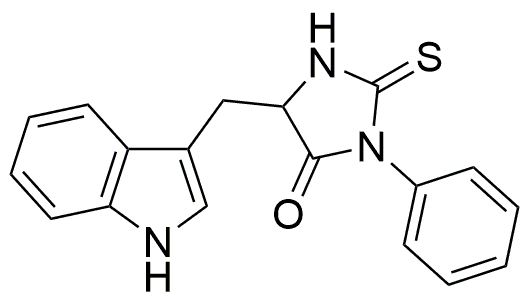Phenylthiohydantoin-tryptophan is widely utilized in research focused on:
- Protein Sequencing: This compound is essential in the Edman degradation method for sequencing proteins, allowing researchers to determine amino acid sequences accurately.
- Biochemical Assays: It serves as a reagent in various biochemical assays, facilitating the detection and quantification of proteins and peptides in complex mixtures.
- Drug Development: In pharmaceutical research, it aids in the design of new drugs by providing insights into protein interactions and stability, which is crucial for developing effective therapeutics.
- Diagnostic Applications: The compound is used in diagnostic tests to identify specific proteins related to diseases, helping in early detection and treatment strategies.
- Research on Tryptophan Metabolism: It plays a role in studies investigating tryptophan metabolism, which is important for understanding various physiological and psychological conditions.
Información general
Propiedades
Seguridad y normativas
Aplicaciones
Phenylthiohydantoin-tryptophan is widely utilized in research focused on:
- Protein Sequencing: This compound is essential in the Edman degradation method for sequencing proteins, allowing researchers to determine amino acid sequences accurately.
- Biochemical Assays: It serves as a reagent in various biochemical assays, facilitating the detection and quantification of proteins and peptides in complex mixtures.
- Drug Development: In pharmaceutical research, it aids in the design of new drugs by providing insights into protein interactions and stability, which is crucial for developing effective therapeutics.
- Diagnostic Applications: The compound is used in diagnostic tests to identify specific proteins related to diseases, helping in early detection and treatment strategies.
- Research on Tryptophan Metabolism: It plays a role in studies investigating tryptophan metabolism, which is important for understanding various physiological and psychological conditions.
Documentos
Hojas de datos de seguridad (HDS)
La SDS proporciona información de seguridad completa sobre la manipulación, el almacenamiento y la eliminación del producto.
Especificación del producto (PS)
La PS proporciona un desglose completo de las propiedades del producto, incluida la composición química, el estado físico, la pureza y los requisitos de almacenamiento. También detalla los rangos de calidad aceptables y las aplicaciones previstas del producto.
Certificados de análisis (COA)
Busque certificados de análisis (COA) ingresando el número de lote del producto. Los números de lote y de partida se pueden encontrar en la etiqueta de un producto después de las palabras "Lote" o "Lote".
Número de catálogo
Número de lote/lote
Certificados de origen (COO)
Este certificado de origen confirma el país en el que se fabricó el producto y también detalla los materiales y componentes utilizados en él y si se deriva de fuentes naturales, sintéticas u otras fuentes específicas. Este certificado puede ser necesario para cumplir con las normativas aduaneras, comerciales y regulatorias.
Número de catálogo
Número de lote/lote
Hojas de datos de seguridad (HDS)
La SDS proporciona información de seguridad completa sobre la manipulación, el almacenamiento y la eliminación del producto.
DownloadEspecificación del producto (PS)
La PS proporciona un desglose completo de las propiedades del producto, incluida la composición química, el estado físico, la pureza y los requisitos de almacenamiento. También detalla los rangos de calidad aceptables y las aplicaciones previstas del producto.
DownloadCertificados de análisis (COA)
Busque certificados de análisis (COA) ingresando el número de lote del producto. Los números de lote y de partida se pueden encontrar en la etiqueta de un producto después de las palabras "Lote" o "Lote".
Número de catálogo
Número de lote/lote
Certificados de origen (COO)
Este certificado de origen confirma el país en el que se fabricó el producto y también detalla los materiales y componentes utilizados en él y si se deriva de fuentes naturales, sintéticas u otras fuentes específicas. Este certificado puede ser necesario para cumplir con las normativas aduaneras, comerciales y regulatorias.


